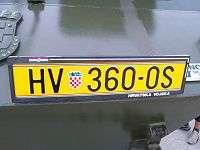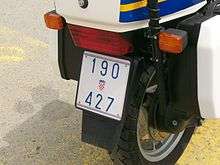Vehicle registration plates of Croatia


The standard license plates in Croatia consist of a two-letter city code which is separated by the Coat of Arms of Croatia from three or four numbers and one or two letters.
Regular plates
The standard regular plate consists of three or four randomly assigned numbers, one or two randomly assigned letters, and the first two letters indicate the city, separated by the Croatian Coat of Arms, while the numbers and the last letters are separated by a dash (example; ZG 000-A, ZG 000-AA, ZG 0000-A or ZG 0000-AA). In recent times, the three-numbered design has been phased out. Since Croatia entered the European Union in 2013, there have been proposals to permanently change the design scheme (consisting of new letter font and ideas to replace the Coat of Arms with four red squares). However, in July 2016, it was determined to keep the original design and add the blue EU-issued sticker (as standard with EU member states). The design of Croatian license plates comes from old Yugoslavian license plates from the 1980s, and it remained the same (with a notable difference of switching the red star, Yugoslavian national symbol, with the Coat of Arms).
Customized plates
There is also a possibility of having a customized plate for a fee. One type of customized plate looks exactly like the standard ones, with the exception that the combination of numbers and letters is personally chosen by the vehicle's owner. The other kind of customized plates can consist of a word with from four to seven letters or a combination of the word with four or five letters and one or two numbers. However, these plates are still quite rare in Croatia, mostly because they can only be used for five years after the first registration and they also require a fee of 8,000 kuna (over 1000 euros).
Special plates


There are also some special plates. While the numbers and letters on standard license plates are colored black, plates for foreign citizens permanently living in Croatia, international organizations and temporary registered vehicles have green numbers and letters. On the plates used on bigger trucks and other vehicles that can be oversized for some of the smaller roads, the numbers and letters are red.
The police vehicles are equipped with the plates consisting of six numbers divided in two groups and separated by the Coat of Arms of Croatia, blue numbers. The first group of numbers denote the police department to which the vehicle belongs. While the background on all of these plates is colored white, on those used on military vehicles it is yellow. However, the system of dividing numbers and letters is the same as on the standard plates, but instead of a city code there are letters HV for Hrvatska vojska (Croatian military). At the same time, specialized military vehicles have the letters VP for vojna policija or MP for military police (military police) as the final two letters. Plates for diplomatic representatives (embassies, consulates) are blue with yellow numbers and letters. The first three number denote the country, followed by letter A, C, or M, then serial number of the vehicle.
As opposed to all above mentioned plates that are made of metal, the dealer's test plates are stickers that are attached to the plate holder. These plates consist of a city code separated by the coat of arms from five numbers divided in two groups and they can be used for a limited number of days.
Starting from 2008 onwards, special plates with an additional two letters (PP or PV) were introduced, PP stands for prijenosne pločice (transferable plates) and PV stands for povijesno vozilo (historical vehicle) in a form CC-PV-NNN(N).[1]
Also from 2008 onwards, export plates are introduced, with RH standing for Republika Hrvatska, and a green background with yellow numbers and letters. Croatia's Ministry of Internal Affairs proposed new licence plates with the EU stars.[2]
National Defense plates had letters NZ and numbers. These plates had been discontinued.[3]
City codes

| Code | Region | Code | Region |
|---|---|---|---|
| BJ | Bjelovar | OG | Ogulin |
| BM | Beli Manastir | OS | Osijek |
| ČK | Čakovec | PU | Pula |
| DA | Daruvar | PŽ | Požega |
| DE | Delnice | RI | Rijeka |
| DJ | Đakovo | SB | Slavonski Brod |
| DU | Dubrovnik | SK | Sisak |
| GS | Gospić | SL | Slatina |
| IM | Imotski | ST | Split |
| KA | Karlovac | ŠI | Šibenik |
| KC | Koprivnica | VK | Vinkovci |
| KR | Krapina | VT | Virovitica |
| KT | Kutina | VU | Vukovar |
| KŽ | Križevci | VŽ | Varaždin |
| MA | Makarska | ZD | Zadar |
| NA | Našice | ZG | Zagreb |
| NG | Nova Gradiška | ŽU | Županja |
Obsolete codes
| Code | Region | Reason |
|---|---|---|
| KN | Krapina | Previously used on Yugoslav plates, but never on plates in independent Croatia, but the code would be mistaken for Knin, capital of, at the time extant, separatist Republic of Serbian Krajina. Krapina was assigned the new code KR, previously (and currently) used for Kranj, Slovenia. |
| PS | Slatina | Podravska Slatina changed its name to Slatina in 1992. These plates are not issued anymore, but still in use. Accordingly, Slatina has new city code SL, starting from 2005 onward. |
| SI | Sisak | Previously used on Yugoslav plates, but never on plates in independent Croatia because it's similar to Šibenik's ŠI. Sisak now uses the new code SK, which is same as for the Macedonian capital, Skopje. |
| SP | Požega | Previously used on Yugoslav plates, but never on plates in independent Croatia since the city changed its name from Slavonska Požega to Požega in 1991. Accordingly, Požega has the new city code PŽ. |
| TK | Titova Korenica | Previously used on Yugoslav plates, but never on plates in independent Croatia (Korenica is now under GS code). |
Partial index of diplomatic, consular and foreign mission prefixes
| Code | Country or Organization |
|---|---|
| 001 | Unknown |
| 011 | |
| 012 | |
| 013 | |
| 014 | |
| 015 | |
| 016 | |
| 017 | |
| 018 | |
| 020 | |
| 023 | Unknown |
| 024 | |
| 026 | |
| 027 | Unknown |
| 028 | Unknown |
| 036 | UNHCR |
| 043 | |
| 054 | Unknown |
| 055 | |
| 058 | Unknown |
| 059 | |
| 064 | Unknown |
| 069 | Unknown |
| 070 | |
| 083 | Unknown |
| 086 | Unknown |
| 087 | |
| 090 | |
| 300 | Unknown |
| 310 | Unknown |
| 318 | Unknown |
| 549 | Unknown |
| 600 | Unknown |
Sources
- "Pravilnik o registraciji vozila" (in Croatian). Ministry of Internal Affairs (Croatia). 2006. Retrieved 2011-09-02.
References
- ↑ automotorsport.hr (26 November 2010). "PV tablice za oldtimere - Džinovski korak naprijed". Retrieved 5 April 2012.
- ↑ New Licence Plates Coming for Croatians
- ↑ Croatia's page on Worldlicenseplates.com
External links
![]() Media related to License plates of Croatia at Wikimedia Commons
Media related to License plates of Croatia at Wikimedia Commons